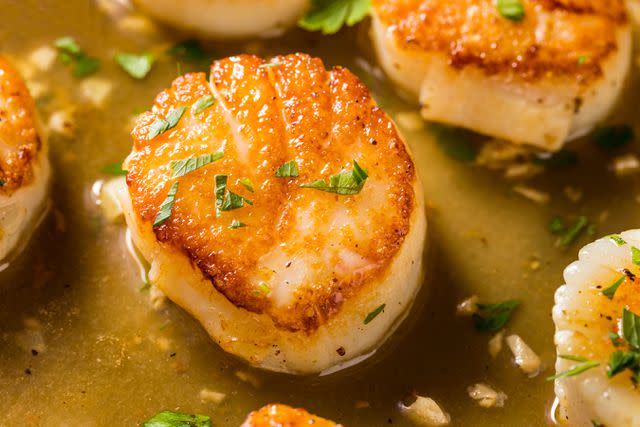Everything You Need to Know About Buying and Cooking Scallops
This chef-favorite shellfish is the secret to fast and elegant meals, from chowder to aguachile.

Brent Hofacker / Getty Images
Scallops are among the most popular types of seafood with chefs and home cooks for good reason. They’re quick-cooking, versatile, and easily available in regular grocery stores and specialty fish markets alike. Here’s what you need to know about scallops, including how to buy and cook them.
Related:Our 24 Favorite Scallop Recipes
What are scallops?
Scallops are bivalve mollusks. The part we eat is the adductor muscle, found between the two shells. There are two common varieties of scallops — bay scallops and sea scallops, named for where they are sourced, whether farmed or wild. Both types of scallops are available year-round, but are at their peak in late fall and winter. Their color ranges from pale pink to cream but color is not an indicator of freshness or flavor. The most obvious difference between these two types of shellfish is their size; bay scallops are significantly smaller than sea scallops. The flavor and texture of each also varies: Bay scallops are known for being slightly sweeter and more tender than sea scallops, which tend to be firmer and brinier.
How to buy scallops
You’ll find sea scallops and bay scallops available fresh or frozen in most grocery stores, most often sold by the pound.
Since sea scallops are significantly larger than bay scallops, you’ll get anywhere from 10 to 30 scallops per pound. They will be labeled according to the number of scallops under a pound, as U10, U20, or U30. As for bay scallops, a pound of this petite variety of shellfish will generally include anywhere from 60 to 100 scallops; the average number per pound hovers around 70.
When shopping for scallops, you may see an additional label that indicates the quality of the fish. “Wet-pack” scallops are treated with a sodium-based brine, which increases their water retention and extends their shelf life. “Dry-pack” scallops are untreated, and are considered to be a more premium product (and so are more expensive). Why? Wet-packing scallops impacts their flavor and makes them more difficult to cook properly. “Not only do treated scallops have a lingering chemical taste, but as they cook, swollen cell walls rupture to release the added liquid, making caramelization difficult,” writes Barton Seaver in The Joy of Seafood. When in doubt, ask your fishmonger whether or not the scallops at the counter are wet- or dry-packed.
Scallops are also labeled with an indication of how they were harvested. Sea scallops labeled as “diver scallops” were individually collected by scuba divers in order to minimize the impact on the ocean environment. These scallops are more expensive, but are among the most sustainably sourced. Day-boat scallops are harvested on smaller boats that stay close to shore.

Brent Hofacker / Getty Images
How to cook scallops
If you’ve ever had chewy, rubbery scallops, then you know how important it is to not overcook them. Scallops should be cooked to just medium; if you want to cook them longer, until just barely opaque inside. Due to their size, bay scallops cook even faster, so are best served stirred into dishes like this Shrimp and Bay Scallop Risotto, or pasta, fish soups, stews, or casseroles. You can use them in recipes that call for chopped sea scallops, like these Scallop Fritters made with clam broth and beer or this herby, nutty Linguine with Scallops, Sun-Dried Tomatoes, and Pine Nuts. This bite-sized shellfish is quick-cooking and tastes delicious as a sweet, briny accessory to other types of shellfish such as shrimp, lobster, or flaky white fish.
Related:12 Quick Scallop Recipes You Can Make in 45 Minutes or Less
Sea scallops also work nicely in pastas and chowders, but can also be grilled, roasted, or pan-seared. You’ll find them seared with citrus, like these Seared Scallops with Pomegranate and Meyer Lemon. You can also wrap them in bacon and roast them in the oven, or grill large scallops with corn. They can be seared and served with a Grenobloise sauce with capers, brown butter, lemon, and parsley.
Be sure to pat sea scallops dry before searing, roasting, or grilling them so they brown better. Both varieties can be cured for ceviche or aguachile, but sea scallops are generally sliced thin before curing. However you prepare them, their sweet flavor and delicate texture is sure to shine.
For more Food & Wine news, make sure to sign up for our newsletter!
Read the original article on Food & Wine.

